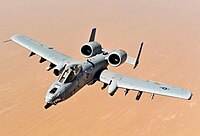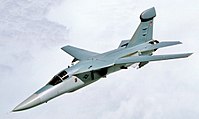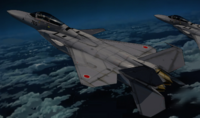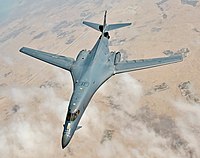Aerospace Defense Force (Hyboria): Difference between revisions
No edit summary |
No edit summary |
||
| (41 intermediate revisions by 2 users not shown) | |||
| Line 13: | Line 13: | ||
| type = {{wpl|Air force}} | | type = {{wpl|Air force}} | ||
| role = {{wpl|Aerial warfare}}<br>{{wpl|Anti-aircraft warfare|Air defense}}<br>{{wpl|Asteroid impact avoidance|Asteroid interception}}<br>{{wpl|Deterrence theory|Nuclear deterrence}} | | role = {{wpl|Aerial warfare}}<br>{{wpl|Anti-aircraft warfare|Air defense}}<br>{{wpl|Asteroid impact avoidance|Asteroid interception}}<br>{{wpl|Deterrence theory|Nuclear deterrence}} | ||
| size = | | size =550,000 active airmen<br>225,000 reserve airmen<br>175,000 civilians<br>8,000 manned aircraft<br>1,200 ICBMs<br>8 [[HALOS (Hyboria)|HALOS]] guns | ||
| command_structure = | | command_structure = | ||
| garrison = | | garrison = | ||
| Line 22: | Line 22: | ||
| colors = <!-- or | colours = --> | | colors = <!-- or | colours = --> | ||
| colors_label = <!-- or | colours_label = --> | | colors_label = <!-- or | colours_label = --> | ||
| march = | | march =[https://www.youtube.com/watch?v=vqhbOQgBy4c Nothing You've Ever Seen Before!] | ||
| mascot = | | mascot = | ||
| anniversaries = | | anniversaries = | ||
| Line 36: | Line 36: | ||
<!-- Commanders --> | <!-- Commanders --> | ||
| current_commander = | | current_commander = | ||
| commander1 = | | commander1 =Nelson Knox | ||
| commander1_label = | | commander1_label = Commander in Chief | ||
| commander2 = | | commander2 =Mason Knight | ||
| commander2_label = | | commander2_label = Secretary of the ADF | ||
| commander3 = | | commander3 =David Richardson | ||
| commander3_label = | | commander3_label = Marshal of the Air | ||
| commander4 = | | commander4 = | ||
| commander4_label = | | commander4_label = | ||
| Line 56: | Line 56: | ||
| notable_commanders = | | notable_commanders = | ||
<!-- Insignia --> | <!-- Insignia --> | ||
| identification_symbol = | | identification_symbol =[[File:FLAGADF.png|100px]] | ||
| identification_symbol_label = | | identification_symbol_label = Flag | ||
| identification_symbol_2 = | | identification_symbol_2 =[[File:US roundel 1942-1943.svg|100px]] | ||
| identification_symbol_2_label = | | identification_symbol_2_label = Roundel | ||
| identification_symbol_3 = | | identification_symbol_3 = | ||
| identification_symbol_3_label = | | identification_symbol_3_label = | ||
| Line 88: | Line 88: | ||
| aircraft_general = | | aircraft_general = | ||
}} | }} | ||
The '''Aerospace Defense Force''' is the air and space force of the [[Hyborian Armed Forces]]. The ADF was first established as the '''Army Flying Signal Corps''' in 1910, later becoming the '''Army Aviation Corps''' in 1914 during the [[2nd Hyborian Continental War]] as a more combat-oriented force. It would be tied to the larger army administration until the late 1940s after the end of the [[3rd Hyborian Continental War]] when it’d be renamed to the '''Army Air Force'''. Following the Federalization of the continent however the force was separated from the army, as the mission profile of the air force expanded greatly to include | The '''Aerospace Defense Force''' is the air and space force of the [[Hyborian Armed Forces]]. The ADF was first established as the '''Army Flying Signal Corps''' in 1910, later becoming the '''Army Aviation Corps''' in 1914 during the [[2nd Hyborian Continental War]] as a more combat-oriented force. It would be tied to the larger army administration until the late 1940s after the end of the [[3rd Hyborian Continental War]] when it’d be renamed to the '''Army Air Force'''. Following the Federalization of the continent however the force was separated from the army, as the mission profile of the air force expanded greatly to include ballistic missile defense, asteroid-interception, and emerging space exploration. | ||
It would get its final name, the '''Aerospace Defense Force''' in 1960. | It would get its final name, the '''Aerospace Defense Force''' in 1960. In the post-[[Omandan Continental War]] environment, the ADF is one of the largest air forces in the world. | ||
The ADF conducts independent air operations along with providing aerial support for the [[Hyborian Army (Annwynn)|Hyborian Army]] and to the [[Hyborian Navy (Annwynn)|Hyborian Navy]]. | |||
==Organization== | |||
===Air Defense Command=== | |||
ADC is in charge of all ground-based air defenses in Hyboria. Working closely with the Continental Air Command, the ADC defends strategic and tactical interests in Hyboria against enemy attack. It also has deployable forces that can be assigned to the FAC, and to an army unit such as a division or brigade. It also works with the Space Command. | |||
===Forward Air Command=== | |||
The Forward Air Command is the primary administration body for all deployed and expeditionary forces outside of continental Hyboria. Established in the 1970s as mobilization and preparation for the Hyborian entry into the [[Omandan Continental War]]. The FAC tackles the challenges that are encountered with expeditionary warfare and its impact on air forces. FAC is not in charge of any development of doctrine or training, but instead is the body in which Tactical Air Command and Strategic Air Command’s training and doctrine are conducted through. It also is the administrative body that all air defense units report to. | |||
===Tactical Air Command=== | |||
Tactical Air Command is in charge of frontline aviation, and by extension with the Continental Air Command, regional air defense of Hyboria. TAC develops doctrine and training for fighter, interceptor, and ground attack pilots and aircraft. | |||
====Continental Air Command==== | |||
Continental Air Command is in charge of fighter aircraft that protect Hyborian airspace. Two types of units assigned to the CAC exist, those who are permanently assigned for dedicated air defense and interception, such as the [[223rd Fighter-Interceptor Squadron (Hyboria)|223rd Fighter-Interceptor Squadron]], and those who are assigned to the CAC but can be deployed to the FAC as needed. CAC permanent units are known as Fighter-Interceptor Squadrons while non-permanent CAC units are known as Tactical Fighter Squadrons. | |||
===Strategic Air Command=== | |||
===Space Command=== | |||
===Special Purpose Command=== | |||
==Personnel== | |||
==Aircraft inventory== | |||
{| class="wikitable" | |||
! style="text-align: left; background: #aabccc; width:20%;"|Aircraft | |||
! style="text-align: left; background: #aabccc; width:10%;"|Photo | |||
! style="text-align: left; background: #aabccc; width:12%;"|Origin | |||
! style="text-align: left; background: #aabccc; width:15%;"|Role | |||
! style="text-align: left; background: #aabccc; width:8%;"|Version | |||
! style="text-align: left; background: #aabccc; width:8%;"|Quantity | |||
! style="text-align: left; background: #aabccc; width:30%;"|Comment | |||
|- | |||
! style="align: center; background: lavender;" colspan="7" | '''Combat Aircraft''' | |||
|- | |||
| {{wpl|McDonnell Douglas F-15 Eagle|Command-Aire F-15}} | |||
| [[File:F-15, 71st Fighter Squadron, in flight.JPG|200px]] | |||
| {{flag|Hyboria}} | |||
| Fighter aircraft | |||
| C<br>D | |||
| 200 | |||
| Latest upgrades include AESA radar and new EW systems. To be used into the 2030s. Being replaced by the F-22 and F-15X. | |||
|- | |||
| {{wpl|Fairchild Republic A-10 Thunderbolt II|Vortech-Wheeler Aerocraft A-10}} | |||
| [[File:A-10_-_32156159151.jpg|200px]] | |||
| {{flag|Hyboria}} | |||
| Attack aircraft | |||
| B<br>C<br>D | |||
| 300 | |||
| Of 1,500 aircraft produced for the ADF, over half lost during the [[Omandan Continental War]]. Less than 300 remain in service. Unmanned D models to replace the single seat C model. | |||
|- | |||
| {{wpl|General Dynamics–Grumman EF-111A Raven|Sprint AeroSystems EF-111B}} | |||
| [[File:EF-111A_Raven.jpg|200px]] | |||
| {{flag|Hyboria}} | |||
| Electronic warfare | |||
| B<br>C | |||
| 70 | |||
|Replacement not yet announced, to be used into the 2030s. | |||
|- | |||
| {{wpl|McDonnell Douglas F-15 STOL/MTD|Command-Aire F-15E}} | |||
| [[File:F-15B C-1984-6457.jpg|200px]] | |||
| {{flag|Hyboria}} | |||
| Fighter aircraft | |||
| E | |||
| 200 | |||
| Used for strike and interception duties, being replaced by the F-15X in the interception and fighter role. Retained by these units for training purposes. | |||
|- | |||
| {{wpl|General Dynamics F-16 Fighting Falcon|Vortech-Wheeler Aerocraft F-16}} | |||
| [[File:F-16_June_2008.jpg|200px]] | |||
| {{flag|Hyboria}} | |||
| Fighter aircraft | |||
| C<br>D | |||
| 1,500 | |||
| Majority of active aircraft have been upgraded to the Block 50/52 model. Reserve aircraft are still Block 40/42 model. | |||
|- | |||
| {{wpl|McDonnell Douglas F-15E Strike Eagle|Command-Aire F-15F}} | |||
| [[File:F-15E_Strike_Eagle.jpg|200px]] | |||
| {{flag|Hyboria}} | |||
| Strike fighter aircraft<br>SEAD | |||
| F<br>G | |||
| 450 | |||
| Used as dedicated deep target strike and SEAD missions. | |||
|- | |||
| {{wpl|McDonnell Douglas F-15 STOL/MTD|Command-Aire F-15X}} | |||
| [[File:SuperF15Kai.png|200px]] | |||
| {{flag|Hyboria}} | |||
| Fighter aircraft | |||
| X | |||
| 450 | |||
| Purchased as a cheaper alternative to the F-22. Some 700 to be purchased in total. | |||
|- | |||
| {{wpl|Lockheed Martin F-22 Raptor|Vortech-Wheeler Aerocraft F-22}} | |||
| [[File:F-22_Raptor_edit1_(cropped).jpg|200px]] | |||
| {{flag|Hyboria}} | |||
| Fighter aircraft | |||
| A<br>B<br>C<br>D | |||
| 400 | |||
| A and B models being upgraded to C and D models. C/D models have new side-facing radar arrays. Fitted with a new targeting system, conformal fuel tanks, and new engines. | |||
|- | |||
| {{wpl|Boeing X-32|Sprint AeroSystems F-32A}} | |||
| [[File:F32fighter.jpg|200px]] | |||
| {{flag|Hyboria}} | |||
| Fighter aircraft | |||
| A | |||
| 350 | |||
| 1,500 F-32 aircraft are ordered in total for the air force. | |||
|- | |||
| {{wpl|Boeing_B-52_Stratofortress|Sprint AeroSystems B-52H}} | |||
| [[File:B-52_Stratofortress_assigned_to_the_307th_Bomb_Wing_(cropped).jpg|200px]] | |||
| {{flag|Hyboria}} | |||
| Bomber aircraft | |||
| H | |||
| 160 | |||
| Used for long-range cruise missile launches. | |||
|- | |||
| {{wpl|Rockwell B-1 Lancer|Command-Aire B-1B}} | |||
| [[File:B-1B_air_refueling.jpg|200px]] | |||
| {{flag|Hyboria}} | |||
| Bomber aircraft | |||
| B | |||
| 100 | |||
| Used in low-level penetration missions. | |||
|- | |||
| {{wpl|Northrop_Grumman_B-2_Spirit|Sprint AeroSystems B-2}} | |||
| [[File:B-2_Spirit_(cropped).jpg|200px]] | |||
| {{flag|Hyboria}} | |||
| Stealth bomber | |||
| A | |||
| 20 | |||
| | |||
|- | |||
|} | |||
[[Category: Hyboria]] | [[Category: Hyboria]] | ||
Latest revision as of 00:40, 23 September 2023
| Aerospace Defense Force | |
|---|---|
| Active | 22 July 1960 (64 years, 4 months as an independent service) 1 December 1910 (113 years, 11 months as an organization) |
| Country | |
| Type | Air force |
| Role | Aerial warfare Air defense Asteroid interception Nuclear deterrence |
| Size | 550,000 active airmen 225,000 reserve airmen 175,000 civilians 8,000 manned aircraft 1,200 ICBMs 8 HALOS guns |
| Motto(s) | "Shield Against the Shattered Skies" |
| March | Nothing You've Ever Seen Before! |
| Commanders | |
| Commander in Chief | Nelson Knox |
| Secretary of the ADF | Mason Knight |
| Marshal of the Air | David Richardson |
| Insignia | |
| Flag |  |
| Roundel | |
The Aerospace Defense Force is the air and space force of the Hyborian Armed Forces. The ADF was first established as the Army Flying Signal Corps in 1910, later becoming the Army Aviation Corps in 1914 during the 2nd Hyborian Continental War as a more combat-oriented force. It would be tied to the larger army administration until the late 1940s after the end of the 3rd Hyborian Continental War when it’d be renamed to the Army Air Force. Following the Federalization of the continent however the force was separated from the army, as the mission profile of the air force expanded greatly to include ballistic missile defense, asteroid-interception, and emerging space exploration.
It would get its final name, the Aerospace Defense Force in 1960. In the post-Omandan Continental War environment, the ADF is one of the largest air forces in the world.
The ADF conducts independent air operations along with providing aerial support for the Hyborian Army and to the Hyborian Navy.
Organization
Air Defense Command
ADC is in charge of all ground-based air defenses in Hyboria. Working closely with the Continental Air Command, the ADC defends strategic and tactical interests in Hyboria against enemy attack. It also has deployable forces that can be assigned to the FAC, and to an army unit such as a division or brigade. It also works with the Space Command.
Forward Air Command
The Forward Air Command is the primary administration body for all deployed and expeditionary forces outside of continental Hyboria. Established in the 1970s as mobilization and preparation for the Hyborian entry into the Omandan Continental War. The FAC tackles the challenges that are encountered with expeditionary warfare and its impact on air forces. FAC is not in charge of any development of doctrine or training, but instead is the body in which Tactical Air Command and Strategic Air Command’s training and doctrine are conducted through. It also is the administrative body that all air defense units report to.
Tactical Air Command
Tactical Air Command is in charge of frontline aviation, and by extension with the Continental Air Command, regional air defense of Hyboria. TAC develops doctrine and training for fighter, interceptor, and ground attack pilots and aircraft.
Continental Air Command
Continental Air Command is in charge of fighter aircraft that protect Hyborian airspace. Two types of units assigned to the CAC exist, those who are permanently assigned for dedicated air defense and interception, such as the 223rd Fighter-Interceptor Squadron, and those who are assigned to the CAC but can be deployed to the FAC as needed. CAC permanent units are known as Fighter-Interceptor Squadrons while non-permanent CAC units are known as Tactical Fighter Squadrons.
Strategic Air Command
Space Command
Special Purpose Command
Personnel
Aircraft inventory
| Aircraft | Photo | Origin | Role | Version | Quantity | Comment |
|---|---|---|---|---|---|---|
| Combat Aircraft | ||||||
| Command-Aire F-15 | 
|
Fighter aircraft | C D |
200 | Latest upgrades include AESA radar and new EW systems. To be used into the 2030s. Being replaced by the F-22 and F-15X. | |
| Vortech-Wheeler Aerocraft A-10 | 
|
Attack aircraft | B C D |
300 | Of 1,500 aircraft produced for the ADF, over half lost during the Omandan Continental War. Less than 300 remain in service. Unmanned D models to replace the single seat C model. | |
| Sprint AeroSystems EF-111B | 
|
Electronic warfare | B C |
70 | Replacement not yet announced, to be used into the 2030s. | |
| Command-Aire F-15E | 
|
Fighter aircraft | E | 200 | Used for strike and interception duties, being replaced by the F-15X in the interception and fighter role. Retained by these units for training purposes. | |
| Vortech-Wheeler Aerocraft F-16 | 
|
Fighter aircraft | C D |
1,500 | Majority of active aircraft have been upgraded to the Block 50/52 model. Reserve aircraft are still Block 40/42 model. | |
| Command-Aire F-15F | 
|
Strike fighter aircraft SEAD |
F G |
450 | Used as dedicated deep target strike and SEAD missions. | |
| Command-Aire F-15X | 
|
Fighter aircraft | X | 450 | Purchased as a cheaper alternative to the F-22. Some 700 to be purchased in total. | |
| Vortech-Wheeler Aerocraft F-22 | 
|
Fighter aircraft | A B C D |
400 | A and B models being upgraded to C and D models. C/D models have new side-facing radar arrays. Fitted with a new targeting system, conformal fuel tanks, and new engines. | |
| Sprint AeroSystems F-32A | 
|
Fighter aircraft | A | 350 | 1,500 F-32 aircraft are ordered in total for the air force. | |
| Sprint AeroSystems B-52H | 
|
Bomber aircraft | H | 160 | Used for long-range cruise missile launches. | |
| Command-Aire B-1B | 
|
Bomber aircraft | B | 100 | Used in low-level penetration missions. | |
| Sprint AeroSystems B-2 | 
|
Stealth bomber | A | 20 | ||